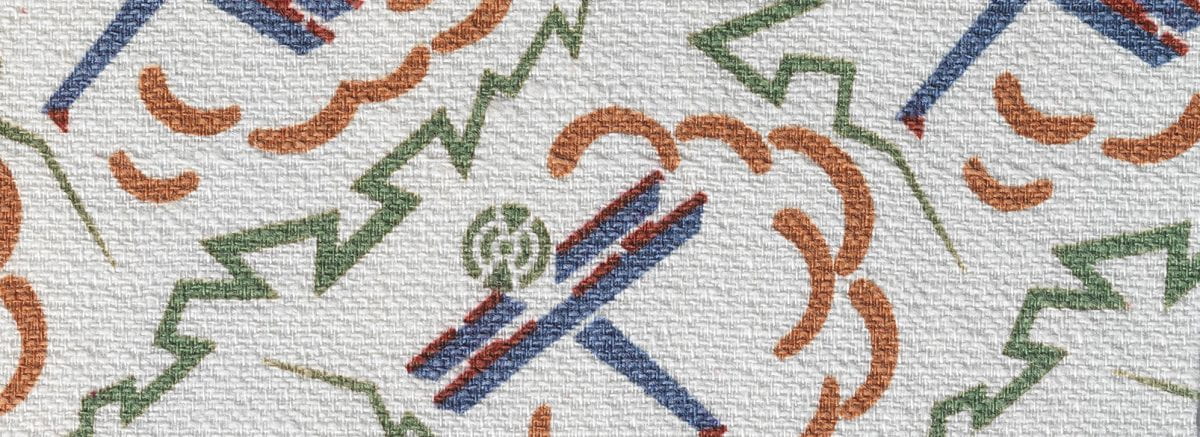Among the Cotsen Textile Traces Study Collection resides T-2102.007, a fetching twentieth-century fragment of twill weave cotton printed with an airplane pattern designed by Sergi Burylin (1876-1942), a talented textile designer of the 1920s.[i] Burylin took part in several exhibitions in the USSR and abroad, including that of the 1925 Decorative Arts in Paris. Born in Ivanovo-Voznesensk, this son of an engraver started work at the Great Manufacturer Ivanovo-Voznesensk, where he created T-2102.007 (titled Airplane), and later at the Ziderev Factory at Ivanovo. Burylins’ artworks are known for their individuality, fertile imagination and the thoroughly textile-oriented approach to the problem of designing rapport fabrics. Found at Imagine Moscow: Architecture, Propaganda, Revolution (March 15–June 4, 2017), and Designing the Modern Utopia: Soviet Textiles from the Lloyd Cotsen Collection (July 26, 2006– February 25, 2007), T-2102.007 speaks to the complex process of modernizing transportation in the USSR under Joseph Stalin (1878–1953).

T-2102.007 belongs to a realm of garments and household textiles that bore designs symbolizing collective modernity and embraced activities in which the new Soviet person would engage (labor, locomotion, education and sports) and marketed revolutionary initiatives enacted by the first socialist government. Airplane possibly recalls the 1928 event in which giant foreign-built airships entered Soviet skies. T-2102.007 features legible abstracted motifs of five in-flight biplanes (and part of a sixth, which is blue) with green propellers. These motifs are among orange smoke clouds and green lightning bolts on pearl-grey ground. Burylin’s design is also seen among Lyubov Nikolaevna Silich’s (1906-1992) A Peasant Woman sateen, which was manufactured via discharge roller printing in 1929.
As the new nation emerged and the Communist party struggled to transform the country into an industrialized state, young Soviet designers began to create thematic designs, sparking a textile-making experiment from 1927 to 1933. Designer’s goals for mass-produced textiles were to encourage the buyers to be ideal Soviet citizens. The hope was that shirts emblazoned with locomotives, speeding skiers, or smokestack-covered bed sheets would lead folks to internalize Soviet dogma and spark inspiration to transform the nation into a cooperative industrial state. Matching the rhythms of a new fast-paced life, captured by rolling wheels, dockyards and words like “development” and “growth,” thematic fabrics were required to both reflect daily life and change it for the better. In essence, aesthetic transitions from calming and pleasurable to static and dynamic were motivated by a need to bring the country out of chaos and set records.[ii]

As early as 1919, trains were prominent in Soviet propaganda, for they played a critical role in the transportation of raw materials from rural areas to factories.[iii] Although some designers working in state-sponsored factories had never seen real locomotives like airplanes and tanks, many used illustrated magazines like Smena or Sovetskoye Foto as references. Their fixation with planes resulted from national efforts to raise public awareness about aviation via the organization of events and lectures, the publication of literature and the creation of clubs and reading circles devoted to aeronautical subjects. Communist party officials continued to embrace the airplane motif as a way of transforming and modernizing the Russian landscape as it brought aviation into daily life, standing as a symbol of technological superiority.[iv] Examples of this can be seen in T-2102.045 (above) which encompasses a pattern of six spinning propellers, two of which are partial, and T-2102.276 (below) which incorporates airplanes and colorful stylized buildings. T-2102.070a also offers an abstract pattern of spinning propellers/rotors.


Using techniques found in Italian Futurism (1916-1919), like repetition and swirling patterns, the design of T-2102.070a (above) is the epitome of dynamism. T-2102.049, associated with the Vladimir Lenin (1870-1924) All-Union Pioneer Organization, offers emblems of flags, stars, buildings, and small airplanes, resembling the symbols of Young Pioneers (red banners, flags, red neck scarfs, bugles, drums and uniforms with badges of rank). One figure near the center blows a horn while others in the crowd beat their drums, recalling rituals and traditions such as the salute, flag-raising and parades by Pioneers. As communist art calls upon scenes of socialist realism, pieces from the Cotsen Collection banish that notion, depicting bold, vibrant and unexpected images that symbolize the idealism of the early Soviet era.

Burylin’s Airplane fabric recalls the spirit of the late 1920s and early 1930s when the construction of new factories, the recuperation of old centers of production and the foundation of technical institutes began to aid in the Soviet Union’s economic transformation. The New Economic Policy of 1921 was partially responsible for initiating the birth of fabrics like Airplane. At this time, Russia opened its borders, allowing in European ideas to influence textile production, and simultaneously deterring pre-revolution printing plates of folk-style plant motifs.[v]Airplane highlights the rhythm and speed of the epoch while showcasing the impetuousness of a young country in transition.[vi]
Notes
[i] Zalëtova, Lidija. Story. In Revolutionary Costume Soviet Clothing and Textiles of the 1920s, 1st ed., 187. New York: Rizzoli, 1989.
[ii] Artdaily. “Soviet Textiles from the Lloyd Cotsen Collection.” Art Daily. Accessed July 12, 2021. https://artdaily.cc/news/16787/Soviet-Textiles-from-the-Lloyd-Cotsen-Collection#.YOxxuS1h3dc.
[iii] Kachurin, Pamela Jill. Soviet Textiles: Designing the Modern Utopia: Selected from the Lloyd Cotsen Collection. 1st ed. Boston: MFA Publications, 2006.
[iv] Gibbons, Julie. “Russia in the 1920s and 30s.” Pattern Observer, November 25, 2013. https://patternobserver.com/2013/11/25/russia-in-the-1920s-and-30s/.
[v] Strizbenova, Tatiana. “The Soviet Garment Industry in the 1930s.” The Journal of Decorative and Propaganda Arts 5 (1987): 160–75. https://doi.org/10.2307/1503942.
[vi] Baker, Therese D. “Soviet Costume and Textiles: 1917-1945.” Choice Reviews Online 29, no. 09 (1992): 196–99.
